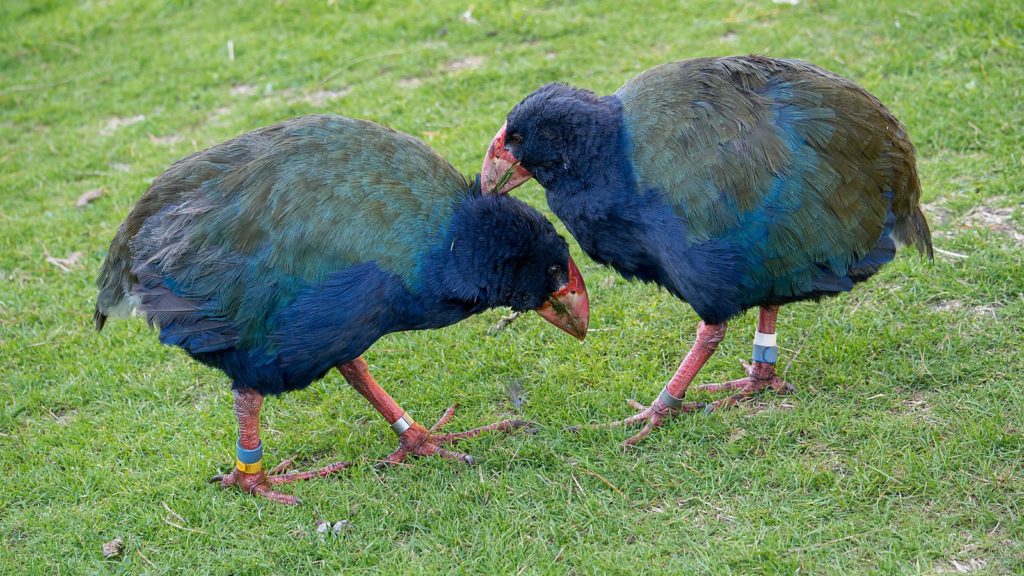
The takahe, a notably large and exceptionally rare flightless bird, was thought to be extinct until fairly recently. This remarkable species has experienced multiple instances of what could be called “resurrections” throughout its relatively brief history known to humanity. Towards the end of August, eighteen of these birds were reintroduced into the mountains of New Zealand with the hopeful aim of increasing the wild population of the species.
New Zealand Phoenix Bird
The initial reference to this prehistoric creature within scientific circles dates back to 1847, but its existence was initially regarded as nothing more than a legend. However, this perception changed in 1849 when hunters accidentally stumbled upon this exceedingly rare bird. The takahe was such a peculiar discovery that they decided to capture, kill, and eat it. This marked the first verified interaction with the takahe.
In 1879, yet another takahe fell prey to a hunting dog, and it did not survive. Its remains were sold to the State Museum of Zoology in Dresden. Unfortunately, this specimen did not endure the test of time, as it was tragically destroyed during the bombings of the Second World War.
Twenty years later, in 1898, another takahe was caught by a dog. The New Zealand government then put its remains on display for the public. For many years, it remained the sole takahe on exhibit worldwide, as the species was believed to have vanished.
Once extinct birds, Takahē, have been returned to the wild in New Zealand. pic.twitter.com/l7Zmp8ywIF
— Pubity (@pubity) August 30, 2023
However, in 1948, a man emerged who refused to accept the takahe’s extinction. New Zealand doctor Geoffrey Buckland Orbell embarked on a determined search that eventually led him to discovering this elusive bird. He meticulously scoured the valley of the Murchison Mountains near Lake Te Anau, following unknown footprints on the ground and hearing enigmatic creaking sounds until he finally encountered a takahe.
This astonishing find prompted the New Zealand government to designate a large sanctuary for the takahe in its natural habitat.
However, this bird has not been seen for the past few decades, at least not until recently only several weeks ago. Now, the takahe is starting a new chapter within its natural habitat in the South Island.
Takahe Bird’s Appearance and Habitat
The takahe is a notably large bird, boasting a body length of about twenty inches and standing at approximately nineteen inches in height. Weighing between 4.5 to 9 pounds, the takahe is equipped with small wings, and its pectoral muscles and keel are underdeveloped, rendering them unsuitable for flight. Instead, this bird employs its wings to navigate the steep slopes of mountainous terrain.
The takahe has short, strong legs, which are a vivid red in color, as is its robust, massive beak. The texture of its feathers is silky, and their color varies depending on the place of the body. Notably, the head, neck, and upper and lower wing areas feature a dark blue hue, while its back and inner wings are a shade of green. The tail also displays an olive green tint.

The takahe is exclusively found in New Zealand and tends to settle in mountainous regions closer to snow-capped peaks or within beech forests. They have a particular attachment for reed beds, moving adeptly in shallow waters and even occasionally taking to swimming.
In terms of their lifestyle and dietary preferences, takahe are active during the day and rest at night. They exhibit strong social instincts and tend to form groups. As the sun rises, they emerge from the thickets of tall grass and forage by traversing grassy slopes. Their diet includes a variety of foods such as cereals, berries, flowers, and herbaceous plants.
Takahe are among the long-lived species of birds, with a lifespan averaging between eighteen to twenty years.
Takahe are monogamous
Takahe form monogamous couples that stay together throughout their lives. In the spring, they build nests, with older birds occupying the best sites, while young ones have fewer opportunities and wait until older individuals perish.
When the nest is ready, the female usually lays one to three eggs. Both parents incubate them for a month. Usually one chick hatches, but sometimes there are two or three. Young chicks are fed snails, worms, and insects. After three months, the chicks join the flock and begin to learn to live independently. By the age of two, they are sexually mature.
See all the latest news from Greece and the world at Greekreporter.com. Contact our newsroom to report an update or send your story, photos and videos. Follow GR on Google News and subscribe here to our daily email!



